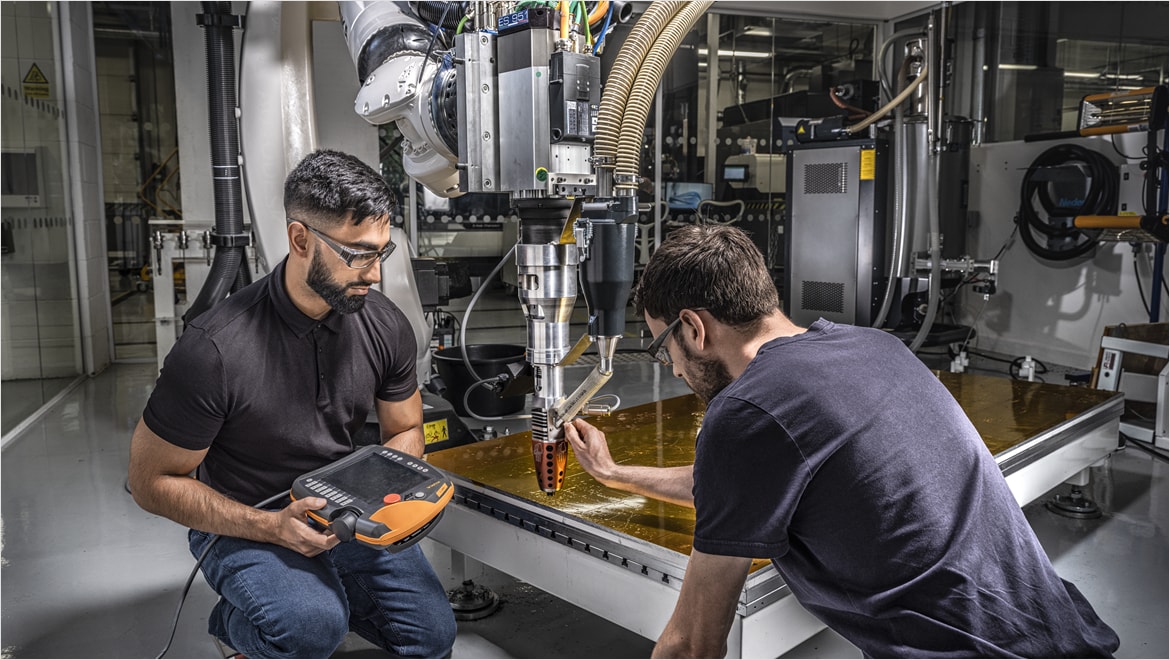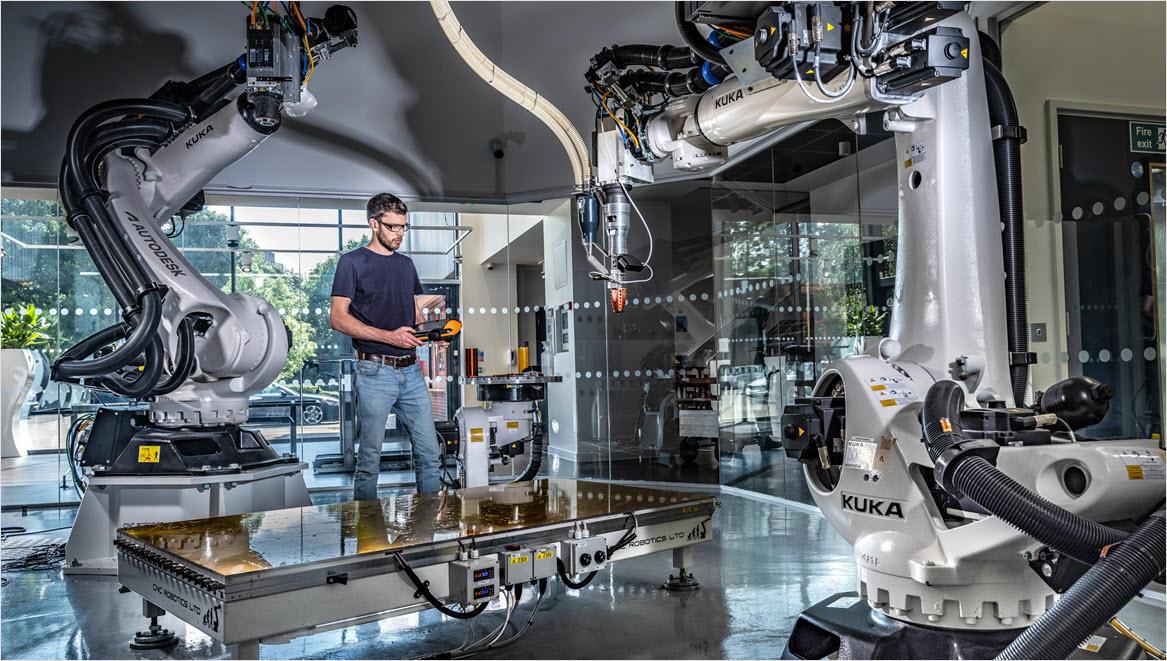& Construction

Integrated BIM tools, including Revit, AutoCAD, and Civil 3D
& Manufacturing

Professional CAD/CAM tools built on Inventor and AutoCAD
Industry 4.0, or the Fourth Industrial Revolution, integrates IoT, AI, big data, and cloud computing to revolutionize manufacturing technologies. It enables the creation of smart factories, facilitates seamless communication between machines, and enhances decision-making processes. Fusion, Autodesk's industry cloud for manufacturing, embodies these principles by providing a unified platform for design, engineering, and manufacturing.
Fusion connects data across all stages, ensuring seamless collaboration and real-time updates, a key component of effectively leveraging Industry 4.0 for your business's growth. Fusion's robust capabilities handle large assemblies and intricate industrial designs, providing precise and efficient engineering solutions for your product development. Its connected data infrastructure enables sustainable insights, optimizing resource use, and reducing energy consumption. Integrated AI and data analytics tools enhance productivity and reduce downtime by predicting maintenance needs and improving process efficiency.
Fusion enables Industry 4.0 with advanced AI tools, process optimization, and data connectivity for manufacturing processes. It offers seamless collaboration through integration with design workspaces, team management, and extensible tools such as our partnership add-ins. Fusion provides robust solutions to analyze machine data and optimize manufacturing facilities and operations. All of this on a single platform drives digital transformation in manufacturing, enhancing efficiency, connectivity, and data-driven decision-making for better overall through put and process optimization.
These Industry 4.0 trends are driving significant advancements in manufacturing, making it more efficient, flexible, and responsive to changing market demands.
IIoT involves the use of interconnected sensors, devices, and systems to collect and analyze data in real-time. It also enables predictive maintenance, real-time monitoring, and automation of processes, leading to increased efficiency and reduced downtime.
AI and machine learning algorithms optimize manufacturing processes, predict equipment failures, and enhance quality control. These technologies enable intelligent decision-making, automate complex tasks, and improve overall production efficiency.
The deployment of collaborative robots (cobots) and automated systems is changing manufacturing. These robots work alongside human operators to perform repetitive or dangerous tasks with high precision, increasing productivity and safety.
3D printing technology allows manufacturers to create complex parts and prototypes quickly and cost-effectively. This trend facilitates rapid prototyping, customization, and on-demand production, reducing lead times and material waste.
Implementing Autodesk Fusion involves strategically integrating its core components to enhance digital workflows: Fusion for seamless CAD/CAM/CAE/PCB operations, Fusion Manage for robust lifecycle management, and Fusion Operations for real-time insights into shop floor activities.
Complemented by Autodesk Platform Services (APS), extensive APIs, professional-grade extensions, and strategic partnerships, these tools create a comprehensive digital ecosystem that supports every phase of manufacturing.
Fusion drives productivity with advanced AI tools, enhancing throughput. It offers AI-driven insights to predict efficient toolpath creation, reduce downtime, and streamline operations. This results in higher productivity, better resource utilization, and more efficient manufacturing processes.
With advanced data analytics and connected systems, manufacturers can quickly adapt to changing market demands and customize products to meet customer requirements. This flexibility allows for mass customization and shorter development cycles, which can help companies stay competitive.
Industry 4.0 technologies enable precise monitoring and control of production processes. This results in higher quality products and reduced defects. Smart manufacturing systems can also optimize the use of materials and energy, minimizing waste and promoting sustainability.
18th to 19th century
The First Industrial Revolution was marked by significant advancements in mechanization through the use of water and steam power. This period witnessed a transformative shift from hand production methods to machine-based manufacturing, leading to substantial improvements in textile manufacturing and the development of iron-making techniques.
19th to early 20th century
The Second Industrial Revolution was characterized by key innovations such as electrification, assembly lines, and mass production. These advancements revolutionized manufacturing processes, leading to the emergence of major industries, including steel, oil, and electricity. Notably, Henry Ford's introduction of the assembly line fundamentally transformed automobile manufacturing, greatly enhancing production efficiency and shaping modern industrial practices.
Mid 20th century
The Third Industrial Revolution was driven by innovations in automation through electronics and information technology (IT). This era marked the integration of digital technology and automation into manufacturing, fundamentally transforming production and business processes. The advent of computers, programmable logic controllers (PLCs), and the internet played a crucial role in this transformation, enabling more efficient and sophisticated industrial operations.
Early 21st century
The Fourth Industrial Revolution is characterized by innovations such as cyber-physical systems, the Internet of Things (IoT), cloud computing, and artificial intelligence (AI). This revolution blurs the lines between the physical, digital, and biological worlds, resulting in smart factories equipped with interconnected machines, real-time data analytics, and autonomous systems. These advancements have led to enhanced customization and flexibility in manufacturing processes, transforming industrial practices on a global scale.
Learn more about how AI, is enhancing smart manufacturing through predictive maintenance, real-time quality control, and supply chain optimization.
Uncover the current challenges for the factory of the future, and how to design use cases for your individual production challenges.
Learn the current challenges for the factory of the futire and how to design use cases for your individual production challenges.
Industry 4.0 helps manufacturers reduce costs, increase profits, and fuel growth. It can also make jobs better, easier, and safer, and help organizations make smarter, faster decisions.
Industry 4.0, faces several significant challenges ensuring data security and privacy, integrating new technologies with legacy systems, and managing the high initial investment costs. Additionally, addressing the skill gaps in the workforce, effectively managing vast amounts of data, and dealing with the lack of standardization are critical issues. Change management, regulatory compliance, scalability, and interoperability also pose significant hurdles. Overcoming these challenges requires strategic planning, investment in both technology and human capital, and a commitment to continuous improvement and innovation.
Industry 4.0, also known as the Fourth Industrial Revolution, encompasses a range of technologies that are transforming manufacturing and related industries. Here are some examples of Industry 4.0 technologies:
The Industrial Internet of Things (IIoT) refers to the interconnected network of industrial devices and machinery that use sensors, software, and other technologies to collect and exchange data. This data is used to monitor, control, and optimize industrial processes, leading to increased efficiency, productivity, and safety.
Industrialization 4.0, also referred to as Industry 4.0, represents the fourth major revolution in manufacturing and industry. It integrates digital technologies and advanced manufacturing techniques to create smart factories and intelligent production systems.


